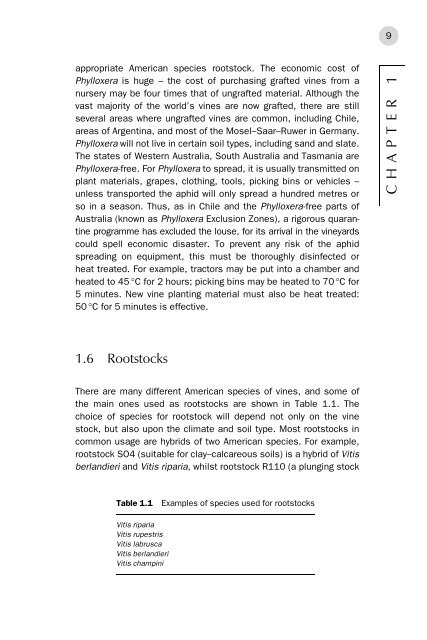Wine Production : Vine to Bottle - Vinum Vine
Wine Production : Vine to Bottle - Vinum Vine
Wine Production : Vine to Bottle - Vinum Vine
Create successful ePaper yourself
Turn your PDF publications into a flip-book with our unique Google optimized e-Paper software.
9<br />
appropriate American species roots<strong>to</strong>ck. The economic cost of<br />
Phylloxera is huge – the cost of purchasing grafted vines from a<br />
nursery may be four times that of ungrafted material. Although the<br />
vast majority of the world’s vines are now grafted, there are still<br />
several areas where ungrafted vines are common, including Chile,<br />
areas of Argentina, and most of the Mosel–Saar–Ruwer in Germany.<br />
Phylloxera will not live in certain soil types, including sand and slate.<br />
The states of Western Australia, South Australia and Tasmania are<br />
Phylloxera-free. For Phylloxera <strong>to</strong> spread, it is usually transmitted on<br />
plant materials, grapes, clothing, <strong>to</strong>ols, picking bins or vehicles –<br />
unless transported the aphid will only spread a hundred metres or<br />
so in a season. Thus, as in Chile and the Phylloxera-free parts of<br />
Australia (known as Phylloxera Exclusion Zones), a rigorous quarantine<br />
programme has excluded the louse, for its arrival in the vineyards<br />
could spell economic disaster. To prevent any risk of the aphid<br />
spreading on equipment, this must be thoroughly disinfected or<br />
heat treated. For example, trac<strong>to</strong>rs may be put in<strong>to</strong> a chamber and<br />
heated <strong>to</strong> 45 °C for 2 hours; picking bins may be heated <strong>to</strong> 70 °C for<br />
5 minutes. New vine planting material must also be heat treated:<br />
50 °C for 5 minutes is effective.<br />
CHAPTER 1<br />
1.6 Roots<strong>to</strong>cks<br />
There are many different American species of vines, and some of<br />
the main ones used as roots<strong>to</strong>cks are shown in Table 1.1. The<br />
choice of species for roots<strong>to</strong>ck will depend not only on the vine<br />
s<strong>to</strong>ck, but also upon the climate and soil type. Most roots<strong>to</strong>cks in<br />
common usage are hybrids of two American species. For example,<br />
roots<strong>to</strong>ck SO4 (suitable for clay–calcareous soils) is a hybrid of Vitis<br />
berlandieri and Vitis riparia, whilst roots<strong>to</strong>ck R110 (a plunging s<strong>to</strong>ck<br />
Table 1.1<br />
Examples of species used for roots<strong>to</strong>cks<br />
Vitis riparia<br />
Vitis rupestris<br />
Vitis labrusca<br />
Vitis berlandieri<br />
Vitis champini
















